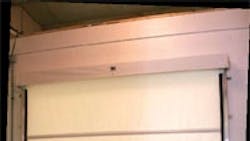By Keith Schmitz
For Armoloy of Illinois Inc. (DeKalb. Ill.), dealing with growth has been a fact of life throughout its 38 years in business. From the outside of the building, the many additions are obvious; however, it could only add on so much. The expansion pressure inside the existing facility recently led the company to erect another building.
To save expansion costs, it wanted to get the most out of its floor space in the blasting room. The 12-foot x 14-foot blasting room was set up within a slightly larger room. It featured a swinging door, which was switched to a powered rollup door from Goff’s. It’s now possible to make better use of the area around both sides of the doorway, plus there are some added benefits.
How it Works In this newly constructed room, Armoloy does the wet blasting precleaning that takes place before the coating process. This hard-coat plating process is not typical. Because of its uniqueness, the coating works on some rather interesting products, from tubes used on nuclear reactors to athletic shoes.
Along with providing the coating for these products, the company also services high-end industries in plastic injection molding, precision bearings, OEM and food processing. For example, the company coats the grilles for a manufacturer that works with McDonald’s. According to Patrick Bradford, plant manager, “We have about 1,100 customers, and at any given time, we’ll have 100-plus open orders.”
Bradford says the process and its technology are so unique and effective that the company had to license it. The process consists of a thin, dense chromium that has an extreme surface hardness and is corrosion resistant. The coating is chip resistant and extremely slippery.
Bradford recounts that the three biggest challenges in putting together this internal room were lighting, exhausting and the door. The job of the door is to contain the materials to the room but still allow for easy accessibility.
Bradford had details for different styles of doors. All used the same approach and were rather expensive. While searching online, Bradford found Goff’s.
Goff’s sent out Pat Mooney, an expert in roll-up doors, to assess the needs at Armoloy. “We were told,” says Bradford, “the Power-Roll door would come in four weeks. It came in two weeks and at a third of the cost of everything else we quoted.”
The feature Bradford likes most about the Power-Roll door is that his crew can pull the side guides apart, clean it and put it back together. “My guys can bend the curtain, pop the rollers, clean it all out and put it back together again,” he says.
The 10-foot x 10-foot Power-Roll door contains the overspray and the dust blasted loose in the pre-cleaning process. An exhaust system evacuates the particles and moisture once the blast cleaning is completed.
The door features a window to allow associates to check on what’s going on in the room. The control box is NEMA-4 rated because of the blasting. The motor gives the door an operating speed of 36 feet per second and is reliable, thanks to the lightweight door curtain.
According to Bradford, the roll door is ideal for the company’s operation. The side-guide design takes up little space around the doorway. Caustics are used in the room, and standard door panels and aluminum side guides would be eventually eaten away if they weren’t protected. The door’s plastic side guides are also resistant to lift truck impact. “And,” says Bradford, “the door’s nonstick vinyl surface can be easily cleaned. There is virtually nothing on the door to corrode.”
Totally capable of closing off the room, the door has a double baffle under the valance to contain the coating within the room. Seals on both sides of the door ensure a tight seal at the vertical edges.
